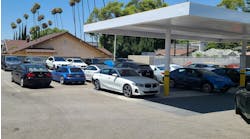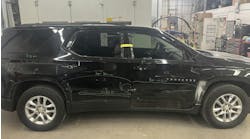Finding and fixing the cause of EVAP leak codes on Asian models can be difficult. Here's how.
EVAP systems are designed to contain fuel vapors so that they can't escape and pollute the atmosphere. These systems have been used on vehicles for decades, but over the past few years EVAP system faults have become much more obvious. This mainly is because EVAP self-monitoring systems have become extremely sensitive and turn the vehicle's check engine light on if problems or leaks are detected. EVAP systems on newer vehicles test themselves for leaks as small as 0.02-inch (the size of a pinhole) — tough to find indeed!
Additionally, because the lines, hoses and components involved often are mounted in difficult to reach areas, locating and isolating leaks can be frustrating and challenging for even the best technicians. And if you do manage to find the leak, verifying the repair also can be a challenge. Precise conditions must be met before the vehicle can run the self-test and confirm that the system is indeed operating correctly, so it can be tough to verify that the problem is actually fixed when repairs are complete.
Unlike other monitored systems, such as a throttle position sensor that can be tested at anytime for abnormal operation, the EVAP system can be tested only under certain conditions involving ambient temperature (above freezing) and pre-determined road test conditions (not just driving for ten minutes or so, but an exact trip pattern) before the control module allows the test to run. Sometimes months can pass before the system sees the necessary conditions and performs a self-test on the EVAP system.
In other words, while reducing evaporative emissions is good for the environment, finding an EVAP leak and making sure it's fixed can be extremely difficult. Asian vehicles in particular can be a bit of a challenge, because many aftermarket scan tools have limited testing capabilities on these vehicles and also because there are many different monitoring methods used among the various Asian vehicle manufacturers.
But never fear — there are ways that you can locate and isolate leaks quickly and fix the vehicle correctly on the first attempt while using common diagnostic tools you probably already have in the shop. You just need to be thorough, patient and resourceful.
Difficult Usually Means Small
Diagnostic trouble codes (DTCs) related to Asian vehicle EVAP systems typically indicate leaks of varying sizes or malfunctions in the EVAP system. However, it's safe to say that most problem EVAP leak codes are from small leaks in the system.Large leaks usually are easy to find with either a visual inspection of these components or by using the smoke machine. Component faults often are pattern failures or easy to locate using the DTC and service information (one shop I know of here in the salt belt keeps vent solenoids in stock). It's the small leaks that cause technicians the most stress.
Checking for technical service bulletins (TSBs) and calibration updates always is important, but it's really important when it comes to EVAP leaks and the related trouble codes, because often the only fix is reprogramming the control module. Even vehicles with known pattern failures have updates available to stop the code from coming back and illuminating the check engine light. Quickly checking for both TSBs and programming updates can save diagnostic time and effort and avoid embarrassing mistakes.However, if there are no TSBs or calibration updates that apply to the vehicle or problem and the leak is really tough to find, here are the two best tips I've ever received for locating troublesome leaks on Asian EVAP systems. First, you can use the scan tool to help in your diagnosis. Second, you actually isolate and test each of the components individually to check for leaks.
The process might take a few extra minutes of effort, but it also works. Here's how.
Beat the Leak
If the problem definitely is a small leak somewhere causing the DTC to set, there are ways to locate and isolate elusive leaks — and they don't involve replacing every component on the vehicle.
As with many diagnostic challenges, locating and isolating troublesome EVAP leaks on Asian vehicles is easier with a plan of attack.
While it is always a good idea to perform a visual inspection before beginning any diagnosis, you do need to resist the urge to wiggle hoses and connections and tighten the fuel cap before EVAP system diagnosis, especially with difficult problems.
The reason for this surprising strategy is that you might inadvertently fix the problem by tightening or moving something and therefore you won't be absolutely sure where the problem was or if it was fixed successfully.Something to note: If there's an advisor or service writer with a habit of wiggling and tightening things before the car goes into the service bay, it might be helpful to explain why this behavior can actually make EVAP diagnosis tougher.
The point of this preliminary visual inspection is only to see if there are any suspicious-looking areas where the leak might be coming from — you'll confirm your suspicions later when you smoke-test the system. After you've visually inspected the system, use the scan tool to command a test if that's possible. The first step is using the scan tool to command the system to seal itself.
There are two tricky things to be aware of with this step. First, note that some scan tools have limited abilities on certain Asian models, so bi-directional communication might not be possible. If that's the case, the solenoids must be energized closed using jumper leads. And second, remember that different solenoids on the same vehicle might be either normally open or normally closed, and it's important to understand what the solenoids are doing when they're not energized.
It's surprisingly common mistake to leak-test an EVAP system with the solenoids in the wrong position. This problem happens more often with vent solenoids that are normally open and must be energized closed. The repair manual will let you know if the solenoid must be energized open or closed. Smoke (or vacuum or pressure — whichever one is being used to test the system) will travel right through an open solenoid which means component might be misdiagnosed as leaking and needlessly replaced.
Fortunately many scan tools have the capability to force the system to go into EVAP test mode which seals the system and makes testing easier. When the EVAP system is properly sealed up, perform the smoke test (follow the directions in the repair manual) in a location without much air flow so the smoke doesn't just blow away. Then gently tap or wiggle the connections to see if the leak is evident. Gently wiggling the connections and lines simulates vehicle movement as the car travels down the road and may identify intermittent, elusive leaks.
Let the Smoke Out
If you're sure that the connections are not causing problems, test each component individually for problems — using a few timesaving tips, of course.
Because removing the canister usually is easy, it's a good place to start. If you plug all of the ports except the one for purging, smoke testing through that port should reveal a leak (if there is one). Again, diagnostic smoke tests are more effective in an area with calm air. Open bay doors or strong overhead fans can make it tough to notice smoke escaping from a small leak.
After testing the canister, check the fuel tank itself and the area around the sending unit (sneaky leaks tend to happen at the top of the tank). Removing the tank for this step would be crazy. Instead, because the canister already has been removed from the previous step, attach the smoke machine to the vent line on the fuel tank (the one that was attached to the canister) and hook up the smoke tester to check for leaks.
If it's possible to access and view the top of the fuel pump, that's even better since the smoke usually doesn't build up enough to show a small leak when you're looking for smoke from the bottom of the vehicle. By inspecting the top of the fuel pump in this way you may well find the problem area that's causing the leak and setting the DTCs.
Lastly, you need to check the purge valve. If it's located under the hood and easily accessible, this is an even easier task. Test the purge valve by pulling the two lines off and smoke testing in both directions. There should not be any leakage.
The line from the purge valve can be plugged at one end and smoke tested at the other. At this stage, wiggling the line at the transitions might reveal a leak similar to when the vehicle is in operation. Active testing it with the scan tool should reveal any leak that may occur when it's cycled opened and then closed again.
Verify the Repair
When you've found and fixed the problem, make sure the controller runs the self-test and that the system passes. This can be tough in the middle of a snowy winter, because the conditions for running the test involve a certain ambient temperature and a specific road test. However, this step is critical.
Use the scan tool to make sure the system has run the self-test and passed. If the test won't run, find out why — it's usually because it's too cold out or because the pre-test driving conditions haven't been met. Park the vehicle indoors with the heat on and look up the specific directions for the EVAP monitor if necessary, but doing what's needed to ensure that the test runs and the vehicle passes will prevent the vehicle from coming back in a few weeks with the same concerns.
Conclusion
Asian EVAP system operation is complicated, and unfortunately that tends to make things more difficult than it needs to be. Unless the problem is an obvious one, such as a missing gas cap or broken hose, finding the EVAP leaks that set diagnostic codes is among the most time consuming, frustrating and difficult tasks that roll through the shop door.
And verifying the problem is actually fixed is also a challenge once the repair is complete, because the problem might not show up again until the next time the monitor runs, possibly even months later. But small EVAP leaks can be located and isolated with a few diagnostic tricks. With patience and practice you'll be able to tackle even the most challenging vehicles.
Vanessa Attwell is a Master Technician for two major manufacturers and has worked in an independent shop. She has developed and delivered training for manufacturers and independents, and helped develop government training and regulations.



